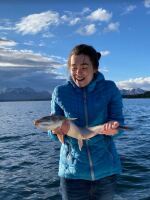Bristol Bay experienced its largest wildfire season on record last year, underscoring a trend toward bigger and more numerous fires in southwest Alaska as the climate warms.
“We really have not seen anything like this,” said University of Alaska Fairbanks climate specialist Rick Thoman. “And the Bristol Bay region was the most extreme of all the extremes,” said University of Alaska Fairbanks climate specialist Rick Thoman.
Fires scorched nearly 650 square miles in the Bristol Bay region last year; more land than has burned in the region in the past 72 years combined.
The Alaska Fire Service boundaries for Bristol Bay stretch from Platinum in the west to north of Iliamna Lake, east to the Gulf of Alaska coast and down the Alaska Peninsula to Port Heiden.

Thoman said the biggest fires were the Koktuli and Pike Creek fires north of Iliamna Lake. But there were other big fires, too, like the Iowithla fire, whichgrew to about 27,500 acres, and burned within about nine miles of Dillingham.
It was by far the largest wildfire on record close to Dillingham, said Thoman.
And there many other fires too, he said, including the Contact Creek fire that ignited early in the season,
“Again, a 10,000 acre fire in a place that we just don't expect this kind of thing,” Thoman said. “So really, it wasn't just, ‘Oh, there was one big fire.’ We had big fires, and they were all over the Bristol Bay region.”
For that to happen, many environmental factors have to align. One ingredient is dry fuel. In Alaska, that fuel is both the forest and the ground cover.
“This is very different than, say, the Lower 48 where what you're going to burn is vegetation above ground," Thoman said. "We have both the above ground and that duff layer right at and just below the surface that is equally flammable, so we've got to get that dry.”
Sun, wind and a lack of rain are all conducive to starting and growing wildfires. And there needs to be a spark. In Alaska, that spark is often lightning.
“We had a burst of lightning from the last days of May through the first week of June, all across southwest Alaska, several days in a row with lots of lightning," Thoman said. "As is typical for early summer thunderstorms, lots of places had lightning, but no significant rain. And that touched off many fires in the course of a few days across southwest Alaska.”

Another factor: snowmelt. Some areas of the region, like north of Ugashik Bay, had an early snowmelt and a warm, dry spring. That meant the tundra dried out earlier. But other areas, like Dillingham, had a lot of snow and rain at the end of the winter, which left a high snowpack.
“The early snowmelt was not so much a factor but the warm and dry weather after the snow was all going certainly contributed,” Thoman said.
Thoman said southwest Alaska crossed a threshold in 2015: Wildfires have gotten larger and more numerous since then. For example, in four separate seasons since 2015, more acreage has burned in the Yukon-Kuskokwim Delta than any other year prior. He called it one of the clearest signals of climate change-induced shifts in Alaska.
“The Elders are telling us there is much more vegetation on the tundra, tundra vegetation is growing higher, it's growing thicker in the transition between boreal forest and the tundra, the trees are growing farther up away from the rivers, the trees near the rivers are growing bigger," he said. "All of that means there's more fuel for fire to burn, once it gets going.”
Thoman doesn’t think next summer will be as extreme as the last one, because too many factors would have to align again. But as the climate warms, he said Alaskans will continue to experience more and bigger wildfires in the future.
Get in touch with the author at izzy@kdlg.org or 907-842-2200.






